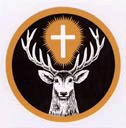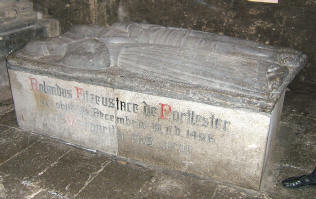|
St. Audeon's Effigy: Dublin
The St. Audoen’s, Dublin, effigy of Roland FitzEustace Lord Portlester and his wife Margaret. This was originally in the chapel which he added to the church in 1455, but has been moved to inside the entrance to the church tower. It bears a strong resemblance to the effigy at New Abbey and represents Portlester and Margaret in the same positions, but the figures and inscription (which in this case is cut to face outwards) are in far better preservation. The armour differs in some respects, the chief being that elbows and shoulders are protected by rondels, and the edge of the shirt of mail just shows below the bottom lame of the plate armour round the hips. The sword, belt and conical helm are very similar, but a visor is just discernable. There are slight differences in Margaret’s dress, especially around the neck. The inscription reads: Orate p a’i’a Rolandi ffytz Eustace militis nunc (?) de Portlest’ qui hu’c locu’ sive capella dedit in honore’ beate Marie V’g’is & etia’ pa’i’a Margarete nup, uxoris sue & p a’i’ab’s omi’ fideliu’ defu’ctor an’o do’ MCCCCXXXXXV. Pray for the soul of Roland fizEustace knight now of Portlester who granted this place or chapel in honour of the Blessed Virgin Mary, and also for the soul of Margaret Jenico formerly his wife, and for the souls of all the faithful dead AD. 1455. The words multis nunc are doubtful. The date, which is difficult to read with certainty, is puzzling, for in 1455 Portlester was neither a knight nor “of Portlester,” and was not yet Margaret’s husband and still less her widower, I think that the date must refer to the erection of the chapel and not that of the effigy. (We know that the chapel was built during that year (1455) but Mr. John Hunt dates the effigy as 1455 and considers that it is the earliest of this period in Ireland. Wares Annals of Ireland also gives this date, but obviously taken from the inscription. It may be that the female figure represents Portlester’s first or second wife and that the inscription was added later.) The plinth, which doubtless had carved panels, is now missing and the figures lie on a stone slab (recently restored) bearing the inscription Rolandus Fizzeustace de Portlester et Margaretta euis uxor. These pages © Ronald Eustice, 2007
|

